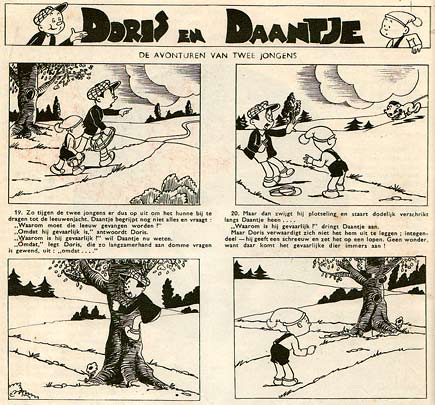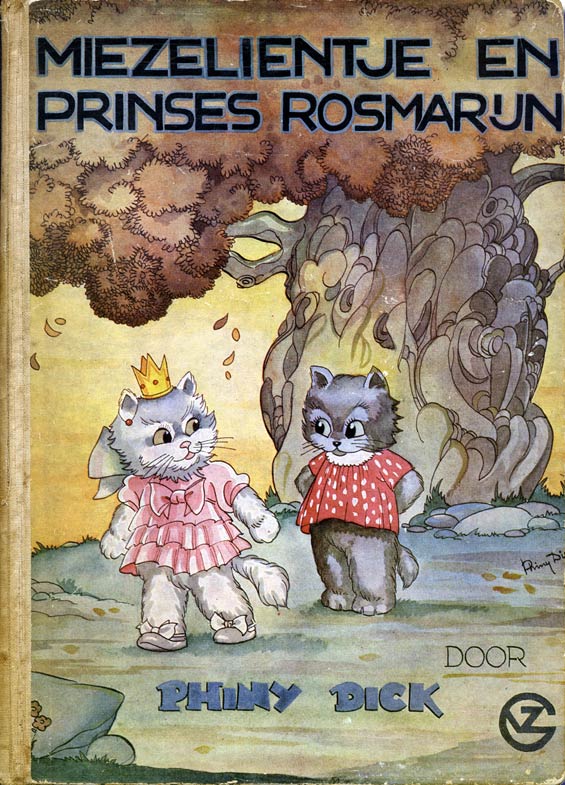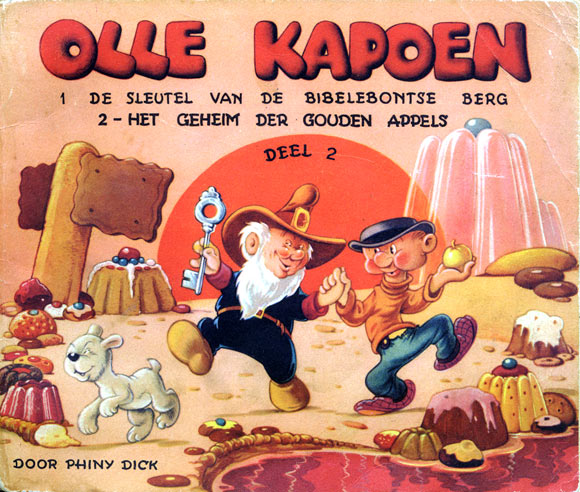Phiny Dick was a Dutch comic artist and painter, most widely known as the first wife of the legendary comic author Marten Toonder. An accomplished writer, illustrator and creative spirit in her own right, Dick worked on several picture books in her younger years, including the 'Miezelientje' series (1938-1946). She also helped her husband with several of his creations, most notably coming up with the name for his signature character, 'Tom Poes'. By the time the Marten Toonder Studio's were established, Phiny Dick served as co-creator and writer of newspaper comics like 'Olle Kapoen' (1945-1954) and 'Birre Beer' (1954-1959). Like many Dutch comics of the time, her work included mostly funny animal and fairy tale comics.
'Olle Kapoen' from Amsterdamsch Dagblad, 29 November 1945 (artwork by Coen van Hunnik).
Early life
Afine Kornélie Dik was born in 1912 in Rotterdam, as the only child into a family with roots in the northern province of Groningen. Her father was a captain with the merchant navy and co-owner of the shipping company Van Nievelt, Goudriaan & Co Stoomvaart Maatschappij (Nigoco). As he was often away from home, Phiny - as she preferred to be called - grew up estranged from her father, who was also a very strict and commanding man. A lonely child, Phiny often fled away in fantasies, having long conversations with her dolls and losing herself in fairy tales and other story books. One of her favorite books was 'The Tales of Mother Goose', of which the illustrations by Gustave Doré particularly captivated her. She was also fond of the fantasy world of A.A. Milne's 'Winnie the Pooh', with illustrations by E.H. Shepard. Both Doré and Shepard became important influences for her own art. Not a very motivated student, young Phiny had more interest in reading stories than paying attention at school.
At the end of the 1920s, the Dik family moved to another address in Rotterdam, where their next door neighbor was also a partner in the Van Nievelt, Goudriaan & Co shipping company. One of his sons later became Phiny's husband, and one of the most legendary comic creators of the Netherlands, Marten Toonder. They had a lot in common. Both their fathers were sailors who were rarely at home and the couple also developed a shared interest in theosophy and esotericism, as well as reading and drawing. As teens, Phiny Dik and Marten Toonder enjoyed the "Roaring Twenties", dancing the foxtrot, the charleston and the quickstep and going to the cinema during the weekends. The crisis of the 1930s caused huge financial stress for the Dik family, who relocated to rural Soestdijk. During weekends, Marten came over to visit his girlfriend.
Originally, Phiny Dik studied to become a chemist's assistant. During her internship as a nurse at the Coolsingel hospital, she fell ill due to an inflammation in her heart muscle and she became a patient in the hospital herself. As frightening as her near death experience had been, Phiny recalled she actually felt quite peaceful during her comatose state. She claimed she never feared death again and the experience motivated her to do something with her life. She gave up her medical profession and decided to follow her lifelong dream of becoming an illustrator. Dick studied painting from sculptor Joannes Diekmann, who later inspired the 'Tom Poes' character Terpen Tijn. She also took a correspondence course in drawing by the British illustrator Percy Bradshaw, who worked at the London Press Art School.
'Doris en Daantje' (Extra Magazine #4, 1935).
Life and work with Marten Toonder
On 14 May 1933, Phiny Dick and Marten Toonder got engaged. By then, Toonder was making a living as a comic artist and illustrator for magazines, books and advertisements. Phiny Dick often helped out with not only the technical and financial, but also the artistic aspects of his work. By 1935, Toonder was a staff artist with the Rotogravure publishing company in Leiden, giving the couple enough financial stability to get married and start a family. They had two sons, Eiso Toonder (1936-2014) and Onno (1944-1999). In the 1950s, they adopted two daughters from an orphanage in Jakarta, Indonesia: Jeannette (1948-1992) and Mari-Lou (1944-2000). As Marten Toonder received more work, his job became a family enterprise. His brother Jan Gerhard Toonder wrote the texts for many of his early comics, while Phiny did the inking. The first Toonder comic strip with her participation was 'Thijs IJs' (1934-1938), a newspaper comic about a polar bear, which appeared in Het Nieuwsblad van het Noorden as a replacement for Mary Tourtel's 'Rupert Bear'. With her husband, Phiny Dick also provided the illustrations for Jan Gerhard Toonder's novel 'De Dag na Bethlehem' (1941).
Early comics
Since her husband was a staff artist with the Rotogravure in Leiden, Phiny Dick also began doing work for this publisher's magazines, for instance as a provider of pastel cover illustrations. She also found work as a children's portrait artist. Between 15 April 1934 and 24 March 1935, Phiny Dick's solo comic 'De Stoute Streken van Stip en Stap' (1934-1935) ran in Extra Magazine, a weekly produced by the Rotogravure for the Jamin candy stores. This first effort was followed by another text comic for the same magazine, 'Doris en Daantje' (1935), about two children. During her maternity leave, her husband temporarily took over this full-page comic feature. For the publisher De Muinck & Co, Phiny Dick designed greeting cards with squirrels and rabbits, while Marten Toonder made illustrations of gnomes and bears for the same company.
'Miezelientje en Prinses Rosmarijn'.
Miezelientje and other children's book
In 1938, Marten Toonder created the character of Tom Poes, a white cat named after the Dutch "tom pouce" pastry. It took until 1941 before the character debuted in its own newspaper strip in De Telegraaf. Besides suggesting the name, Phiny Dick also wrote the captions for the first six episodes of Tom's debut story, 'Het Geheim der Blauwe Aarde' (1941), but she eventually decided that the character didn't suit her that much. By that point, she felt more at ease with her own creation, the Angora cat Miezelientje, whose adventures were set in a happy and carefree forest, called Poesenoord. In 1938 and 1939, Miezelientje's first adventures appeared as text comics in the Rotogravure magazine Onze Club-Krant. Afterwards, she created three books with the character for publisher G.B. van Goor Zonen: 'Miezelientje en de Prinses Roosmarijn' (1939), 'Miezelientje en Kakeline de Kip' (1941) and 'Miezelientje en Wol de Beer' (1948). At the suggestion of her publisher, Phiny Dik signed her work as "Phiny Dick", to make her name look more artistic.
For the same publisher, Phiny Dick wrote and illustrated several other children's picture books: 'Oli Fant uit Poppelo' (1940), 'Pijper, het Bosmannetje' (1940), 'Sinterklaas, Kerstmis en Nieuwjaar' (1941), 'Suizebol en Bijdepink' (1941), 'Pom, Verk en Fop' (1941) and 'Pom Van De Pomheuvel' (1943). The latter two books featured characters that Dick later redeveloped for her post-war comic strip series 'Olle Kapoen'. However, the two protagonists, Pom the gnome and Verk the pig, weren't creations of her own, but thought up by her infant son Eiso. In 1941, Dick also illustrated books about children's games and nursery rhymes.
'Sinterklaas, Kerstmis en Nieuwjaar'.
World War II traumas
In 1944, Dick gave birth to their second son Onno, but this happened in difficult circumstances. Because of World War II, the hospital conditions were less than favorable and Dick suffered an exhausting birth process as a result, once again dangling between life and death. Mother and child survived, but she had to remain in bed for several months to let a thrombosis in her leg heal. Doctors advised her to move as little as possible, which was frustrating for a creative woman like her. By the time she was allowed to leave the hospital, she had lost a lot of weight. Dick eventually got healthy again, but another traumatic event happened soon after, as described in Wim Hazeu's 2012 biography of Marten Toonder.
One day, when her husband was out, the Sicherheitsdienst (SS) held a raid at her home, looking for Fritz Gottesmann, Marten Toonder's Jewish businessman who was in hiding. She refused to tell them anything, until they threatened to send her to concentration camp Vught and put her two children in an orphanage. When the officer in question also threatened her baby's life, she succumbed to the pressure and gave them Gottesmann's address. Gottesmann was arrested the same month and sent off to Nazi camp Mauthausen, where he died in February 1945. All these traumatic events became too much for Phiny Dick. As a creator of happy carefree children's stories, she couldn't cope with the harsh reality of the war times and the guilt she felt over what happened. She fell into a severe depression, but nevertheless tried to clear her mind by writing another children's novel, 'Schuimpje en Zigzag'. Yet her publisher objected to an illustration of a bare-breasted mermaid in her manuscript. As she refused to alter it, the book never came out. Having lost her only escapist project, Phiny Dick refrained from writing and drawing until the end of the war.
When peace returned to the country, Dick resumed her artistic career. Even though she published a third installment in her 'Miezelientje' book series, she no longer felt able to write innocent children's stories. A telling example of how the war changed her was a little text she wrote two weeks before Nazi Germany capitulated. The unpublished writings seem to be a foreword for a reprint of one of her 'Pom the Gnome' novels, but have such a cynical tone that it's understandable why they were not used. Dick writes how Pom "probably lost a lot of weight from the hunger he suffered during the war" and hides "his non-Aryan friend Rits the squirrel in his cellar." All other characters are now working "on the black market", while Owl is "now suspicious since he used to be a member of the Kulturkammer". Finally, Dick bitterly remarked that their forest might be "burned down, but if it survives she might once again tell some little adventures in which (...) treasure hunts will be the biggest sensations."
'Olle Kapoen'.
Toonder Studio's
During the 1940s, Marten Toonder's own graphic studio evolved into a lucrative enterprise, and eventually became the largest production house of comics and animations in the Netherlands. During this period, Phiny Dick's involvement in Marten Toonder's comic projects slowed down. As she was taking care of the children, Toonder supervised a whole staff of writers and artists for both his comics and film productions. Throughout the rest of his career, Marten Toonder remained devoted to Phiny as a partner, and often consulted her when creating new storylines for his comics. Sources differ on this matter, but Dick was possibly involved in the early writings of her husband's post-war creations 'Kappie' (1946-1949, with Dirk Huizinga) and 'Panda' (1947-1948, with Jan Gerhard Toonder). Still, the couple grew apart on a professional level, as both made their own separate contributions to the Toonder Studios.
Olle Kapoen
Even though she never wrote children's novels again, Phiny Dick's post-war text comic creations had virtually the same innocent child-friendly and carefree themes. Her best-known creation 'Olle Kapoen' (1945-1954) even featured the same gnome and animal characters from 'Pom, Verk en Fop'. While side characters like Verk the piglet and Uil the Owl reappeared under their original names, the chubby bearded gnome Pom was now called Olle Kapoen and the beardless gnome Puk rechristened Puck Toffel. Precise credits are unknown, but Phiny Dick at least wrote the early stories and possibly also participated in some of the artwork. Three stories of a first series - the third remained unfinished - were illustrated by Coen van Hunnik and ran from 22 October 1945 until 27 February 1946 in Amsterdamsch Dagblad. After that, the comic moved for its second series to Algemeen Handelsblad (2 November 1946-30 October 1954) and Het Binnenhof (1 December 1954-15 November 1955). According to her son Eiso, Phiny Dick illustrated the first fourteen stories of the second series herself, but it is believed that Toonder Studio staff artist Richard Klokkers did much of the artwork for the 82 stories of the Algemeen Handelsblad-Het Binnenhof run. Wim Lensen, another staffer, also participated in the later productions.
In 1958 and 1959, four stories were reworked to the balloon comic format for the weekly Disney magazine Donald Duck, presumably by Andries Brandt and Hans van Gorkom. The Toonder Studio's sales representative Anton de Zwaan also sold the series abroad. In Belgium, 'Olle Kapoen' appeared in the weekly De Zweep and newspaper Het Laatste Nieuws, and also in French as 'Chapon' in the newspapers Le Républicain Lorrain and La Croix. In the Norwegian magazine Norsk Ukeblad, 'Olle Kapoen' appeared as 'Tobias'. In Sweden, the comic was published under two different titles in Vårt Hem and Svenska Dagbladet, respectively as 'Ole Kapon' and 'Barney Bump'.
Tom Poes collections in the "Literaire Reuzenpocket" series of De Bezige Bij (1970s).
Birre Beer
On 27 December 1954, Dick launched her final comic feature in newspaper Algemeen Handelsblad, the funny animal text comic 'Birre Beer' (1954-1959), drawn by Ton Beek. A week before its publication, the editors introduced their upcoming comic star Birre Beer as "the son of Mary Tourtel's 'Rupert Bear', whose adventures had appeared earlier in this newspaper. The 'Birre Beer' text comic told the adventures of a little bear named Birre whose naïvité always gets him in trouble. He is a good friend of Mirre, the daughter of a woodsman, and Socratov the mouse, who both frequently help him out whenever the need is highest. It is believed that Phiny Dick scripted the first 27 stories, running between 1954 and 1957, after which her son Eiso Toonder and then Andries Brandt took over the writing until the final episode on 28 March 1959. During the 1960s and 1970s, the 'Birre Beer' stories were reprinted in the newspaper Trouw and the Flemish children's magazine 't Kapoentje.
Later life and death
Phiny Dick was also an accomplished portrait painter and creator of tapestries. When in 1965 she and her husband moved to the Irish town of Greystones, she devoted the rest of her artistic work to painting by nature. She also painted the covers for several of the 'Tom Poes' pocket book collections published by De Bezige Bij. In 1985, an exhibition of her work was held at Galerie Brink 7 in Yde, the Netherlands. Phiny Dick passed away in 1990, after a short coma. Her husband felt immense grief over her death and survived her for 15 more years.
Legacy and influence
A bridge and a canal are named after Phiny Dick in the "Comics heroes" district of the Dutch city Almere. The district also has a street named after 'Olle Kapoen', the Olle Kapoenstraat.
Books about Phiny Dick
In 2012, Eiso Toonder wrote a 16-page booklet about his mother named 'Portret van Phiny Dick'.











